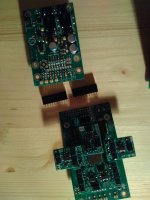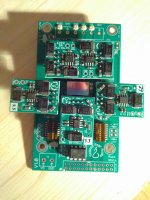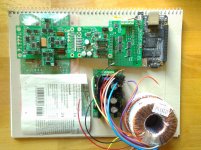-snip-
My observation is that I have had success with players that do DoP well. Especially MPD/Volumio etc (even A+ did fine with DoP 1.0 and DSD64)...
Hi Russ,
I'd like to report my experience focusing on A+ and HQ Player running on my Macbook with the USB output to Hermes-Amanero/Cronus (22/24 clocks on board) with Puresync firmware on 9028 pro. The I2S serial lines including MCLK were transferred to the DAC via Teleporter as stated in the other thread with the distal end of MCLK directly connected to the clock input on the DAC.
As for A+, I could play all of DSD64, DSD18 and DSD256 sources without a bit of noise with Puresync firmware, regardless of the DoP version (i.e. 1.0 or 1.1), quite consistent with what you described before, though different from the results of noise-contaminated DSD64 and DSD128 play using ALSA on HQP running on linux (Ubuntu 18.04).
Playing DSD256 is quite okay sufficing 128fs but playing DSD64 and DSD128 sometimes becomes quite noisy as if the volume was exceeding the maximum loudness or contrarily quite diminutive with an increase of background white noise. This issue usually disappear when restarting the software. I'm not sure this is due to the interaction of core audio with the firmware or with the software.
More interestingly, the HQP on Macbook for playing DSD always forced the sources to noise-free DSD256 format, regardless of explicit setting as DSD64 or DSD128.
I hear that some application outputs its final format as PCM even after DSD decoding. I'm wondering this could be relevant to the current issue.
Anyway I hope this report can be of help, though small, for your further consideration.
TW: interesting, here DSD 256 will not play with a 22.5792 XO, I need 45.1584 for that.
running Amanero/Cronus, sync clock (but not sync mode firmware). Linux (Sonore Rendu), with Amanero 1099c, native DSD input to Amanero. If the sync mode firmware allows for 1x clock and success with 9028/9038 and DSD 256 that is very interesting, as of course the 1x clocks have lower phase noise...
oh yeah, Audirvana +, but streaming (Ethernet) to Sonore Rendu (linux based).
BTW, Russ: I really love sending DSD to the 9038, and oversample everything to DSD, so DSD performance (prefer 256 when I can get it) is very important to me.
And, 9038/Mercury is really impressive, thanks for that!
running Amanero/Cronus, sync clock (but not sync mode firmware). Linux (Sonore Rendu), with Amanero 1099c, native DSD input to Amanero. If the sync mode firmware allows for 1x clock and success with 9028/9038 and DSD 256 that is very interesting, as of course the 1x clocks have lower phase noise...
oh yeah, Audirvana +, but streaming (Ethernet) to Sonore Rendu (linux based).
BTW, Russ: I really love sending DSD to the 9038, and oversample everything to DSD, so DSD performance (prefer 256 when I can get it) is very important to me.
And, 9038/Mercury is really impressive, thanks for that!
Last edited:
I am going to start a new thread around the PureSync beta firmware - since probably 98% of users are not interested... yet! 🙂
@barrows - without PureSync you would not be able to do DSD256 with 22mhz clock.
DSD support is important to me too - it's just that a huge percentage of my collection is PCM and I just have not felt the need to re-sample to DSD 🙂 Still - it does not mean I don't want to give it a try. I do have some native DSD material - it's just not a large portion of my library.
Thanks again to all of you brave souls involved in the beta. The data/feedback is appreciated!
Cheers!
Russ
@barrows - without PureSync you would not be able to do DSD256 with 22mhz clock.
DSD support is important to me too - it's just that a huge percentage of my collection is PCM and I just have not felt the need to re-sample to DSD 🙂 Still - it does not mean I don't want to give it a try. I do have some native DSD material - it's just not a large portion of my library.
Thanks again to all of you brave souls involved in the beta. The data/feedback is appreciated!
Cheers!
Russ
TW: interesting, here DSD 256 will not play with a 22.5792 XO, I need 45.1584 for that.!
I know that 45/49 clocks are essential for every experiment. But, as I wrote before, getting the current beta firmware of syncmode appears mandatory for your purpose because I think that I could prove that 22/24 clocks are sufficient for it.
If it is difficult to get the beta firmware, the next step will be to get an AVR programmer for copying hex files. I think it is not that difficult because the basic command lines for copying had been already open in this thread. An AVR Dragon will be my recommendation.
Russ,
Perhaps another useful bit of info. Was playing DSD128 fine (from A+ DoP1.0) and after a few minutes audio stopped for a couple of seconds, then came back on but with lots of background white noise on top of the music.
Perhaps another useful bit of info. Was playing DSD128 fine (from A+ DoP1.0) and after a few minutes audio stopped for a couple of seconds, then came back on but with lots of background white noise on top of the music.
Hmm - which trident? It should be the trident that powers the XO. VDD trident powers the VDD supply of the DAC.
Also make sure you have the switch to select sync mode set.
Sorry, lost again, where do I find this Sync Mode Set Switch? is this a physical switch?
Alex
Hi Russ,-snip- The display I am using in the pic is a VFD display with a 4-bit compatible LCD interface.
Russ
I happened to have this kind of LCD interface (PCF8574 I/O expander) but I think it's 8-bit compatible. Here I have a few questions:
Can I use this 8-bit PE for this purpose?
Do I need to change the address of LCD_PE in I2C_CharDisplay.h and recompile to make a hex file?
Which header pins will be available for connection: via I2C header or GPIO header? If the latter, which pins can be connected to?
Thank you.
Sorry - I should have explained.
The ES9028/38 have a register for "clock gearing".
What it does is basically "gear down" the clock by dividing it by 1, 2, 4, or 8. This is intended as power saving feature (in fact ESS calls that out in the DS) - it allows you to run the DAC with less current for lower sample rates.
BTW in PureSync mode DSD64 plays exactly the same for me with the clock geared or not. Still - reducing the power required could have other positive effects for some.
I learned a lot chatting with ESS both about PureSync and clock gearing.
Cheers!
Russ
Thanks for the explanation of clock gearing and phase mode DSD. I'm not running any external control. Not sure what your plans are for enabling this feature but unless it's done through the onboard switches, it's not an option for me. As far as phase mode DSD is concerned, I can't say for sure but I suspect that this would be an unusual way for DSD to be handled?
Help!, I have been trying to get my RP3 B / Kali reclocker and Volumio via I2S into my BIIIse pro and I have been having problem running 44.1khz music. Any music with higher freq that I have works ok, but not 44.1khz, I get noise, why? Can anybody please help me? figure out what I am doing wrong? Maybe setup on Volumio? or maybe my RP3 B is defective? Help!!
Alex
Alex
Have you set up Volumio to only output 32bit audio?
Sorry, but how do you check this setting? Sorry for the ignorance.
Alex
Have you set up Volumio to only output 32bit audio?
I got it, thanks. I just found out that this is a bug in Volumio, after reading their forum. One thing I noticed is that when playing DSD file (DFF or DSF file), that it gets converted to PCM. I am not sure if Volumio is doing it or the Kali reclocker, but I am almost sure it gets converted. Am I correct?
Alex
Considering that Kali does not support DSD output yet you are hearing music, you are correct. 🙂
I am done assembling the Buffalo 9038 with Mercury but I think I may have an issue with the Buffalo board.
I cannot get a lock from the Amanero but the real issue is that DVCC is reading 0.5V on the Trident.
The input to Buffalo is 5.1V, and all other readings look good:
AVCC 3.6V, VDD 1.3V, VDD_XO 3.3V.
I swapped the 3.3V tridents and the readings are the same, so it seems that both tridents are working properly.
The input pins of DVCC read 5.1V.
I initially had soldering issues with the VDD pins and thought I may have damaged the board (one pad was partially lifted), but ultimately the reading there looks correct.
I also used an ESD bracelet when interacting with the board although not sure on their effectiveness.
Any idea's besides a damaged board?
I cannot get a lock from the Amanero but the real issue is that DVCC is reading 0.5V on the Trident.
The input to Buffalo is 5.1V, and all other readings look good:
AVCC 3.6V, VDD 1.3V, VDD_XO 3.3V.
I swapped the 3.3V tridents and the readings are the same, so it seems that both tridents are working properly.
The input pins of DVCC read 5.1V.
I initially had soldering issues with the VDD pins and thought I may have damaged the board (one pad was partially lifted), but ultimately the reading there looks correct.
I also used an ESD bracelet when interacting with the board although not sure on their effectiveness.
Any idea's besides a damaged board?
Attachments
I am done assembling the Buffalo 9038 with Mercury but I think I may have an issue with the Buffalo board.
I cannot get a lock from the Amanero but the real issue is that DVCC is reading 0.5V on the Trident.
The input to Buffalo is 5.1V, and all other readings look good:
AVCC 3.6V, VDD 1.3V, VDD_XO 3.3V.
I swapped the 3.3V tridents and the readings are the same, so it seems that both tridents are working properly.
The input pins of DVCC read 5.1V.
I initially had soldering issues with the VDD pins and thought I may have damaged the board (one pad was partially lifted), but ultimately the reading there looks correct.
I also used an ESD bracelet when interacting with the board although not sure on their effectiveness.
Any idea's besides a damaged board?
It sounds like there is damage to the vias for the Trident from the desoldering. It's a four-layer board, so that damage is likely internal.
Can you see if either of the non-GND pads for that Trident are shorted to GND?
Last edited:
It sounds like there is damage to the vias for the Trident from the desoldering. It's a four-layer board, so that damage is likely internal.
Can you see if either of the non-GND pads for that Trident are shorted to GND?
DVCC: (the problematic one)
IN-GND 300Kohm
OUT-GND 0.8ohm
VDD_XO:
IN-GND 250Kohm
OUT-GND 11Kohm
VDD: (desoldering of header was here)
IN-GND 450Kohm
OUT-GND 33ohm
For anyone interested here is firmware that handles both "pure-sync" (128-fs) mode and shows you a display of the current volume.
Also note that this firmware allows for clock gearing if you like (normal or div2) - this is handy when you want to consume less power and you don't plan on running 384khz etc. Another thing for people to tweak as they desire. 🙂
The display I am using in the pic is a VFD display with a 4-bit compatible LCD interface.
GitHub - twistedpearaudio/Buffalo-III-SE-Pro-On-Board-Firmware at WithDisplay
Cheers!
Russ
Once I get my Buffalo working I want to add some more functionality to the basic display.
I took a look at the code in the repo and it looks straightforward.
I plan on using fixed output so was thinking of displaying the current bit/sample rate instead.
Is that readable from the Buffalo i2c?
I finally started to build my Buffalo-IIIsePro38 and a couple of questions popped up (probably not the last 😉):
1. Related to the connection between Cronus and the Buffalo board. There are 2x12 connection pins, but I only got two 2x10 female connector. I will just cut one apart to build my own additional 2x2. Its correct to connect all 2x12 pins, right?
2. Are the two 3,3V regulators identical? So, the connectors DCVV and VDD_XO are interchangable?
3. Is there anything else except the male header to connect to the regulators? There are additional contacts and I saw soem pictures with LEDs.
4. Are the connectors LOCK and A_MUTE on the Buffalo board intended for the two LEDs? Can I use them to show that the Buffalo is powered on at the case? Or which one am I supposed to use for that purpose?
5. Is it a common choice to use the volume poti at the Buffalo? I think controlling the volume via software and at my amp will suffice or am I missing something?
Thank you!
1. Related to the connection between Cronus and the Buffalo board. There are 2x12 connection pins, but I only got two 2x10 female connector. I will just cut one apart to build my own additional 2x2. Its correct to connect all 2x12 pins, right?
2. Are the two 3,3V regulators identical? So, the connectors DCVV and VDD_XO are interchangable?
3. Is there anything else except the male header to connect to the regulators? There are additional contacts and I saw soem pictures with LEDs.
4. Are the connectors LOCK and A_MUTE on the Buffalo board intended for the two LEDs? Can I use them to show that the Buffalo is powered on at the case? Or which one am I supposed to use for that purpose?
5. Is it a common choice to use the volume poti at the Buffalo? I think controlling the volume via software and at my amp will suffice or am I missing something?
Thank you!
Attachments
Last edited:
I already got a case matching my other equipment. I thought it will be plenty of space. I was obviously mistaken 🙂.
The line on the cardboard marks the front border of the case. The piece of newspaper is the missing Placid HD BP Power Supply. And there still needs to get an SSD in there for storing my music. I want to put it below the beagle board. What do you think about these two setups? Is it a problem to stack the transformers?
The line on the cardboard marks the front border of the case. The piece of newspaper is the missing Placid HD BP Power Supply. And there still needs to get an SSD in there for storing my music. I want to put it below the beagle board. What do you think about these two setups? Is it a problem to stack the transformers?
Attachments
I would not stack the transformers. the second pic is better. even better would be to put them at right angles. I would also suggest using a NAS to store your music.
- Home
- More Vendors...
- Twisted Pear
- Introducing the Buffalo III-SE-Pro 9028/9038




